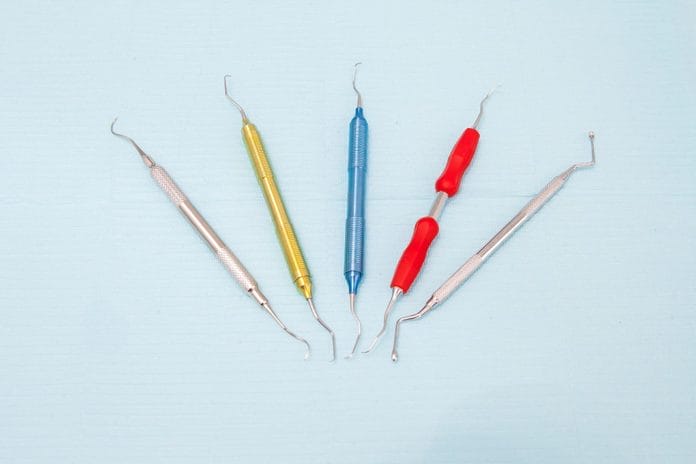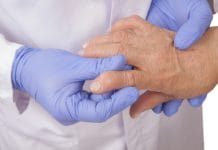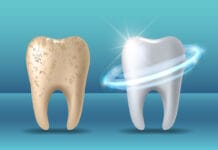Sharp instruments are critical for both dental clinician and patient. From the patient standpoint, they are much more comfortable as less pressure is applied to remove calculus. When sharp instruments are used, the amount of time for the procedure is reduced. Gingival tissues respond better when fewer repetitive strokes are used, and less pressure is applied.
Comfortable dental patients with greater outcomes create the opportunity for word of mouth referrals as patients share their overall experience. Simply, happy patients share their experiences with friends and family, providing a potential revenue stream for the office.
From the operator standpoint, perfectly sharp instruments increase tactile sensitivity and require less pressure to remove deposits, creating less strain and hand fatigue, decreasing the risk for musculoskeletal injury, allowing for greater career longevity. This alone should make the use of perfectly sharp instruments mandatory for all.
Finding Little Time to Sharpen
The instrument sharpening issue seems simple, yet in day to day life, who among us has the precise technique and the time available to sharpen as needed? Most hygienists are scheduled so tightly with active patient treatment that there is little time to sharpen. It is also rare to have such an excellent sharpening technique that the instrument shape remains intact and effective over time.
Poorly angled instruments can cause issues such as tissue trauma. How often do you find an instrument that has been sharpened so poorly there is absolutely no blade left? I often joke that I am given soup spoons to scale with at some offices! Unfortunately, even the most skilled clinician using dull instruments can ultimately burnish calculus, causing more long-term issues for the patients’ health.
There are several methods to sharpen instruments − sharpening stones of various materials, shapes, abrasivity, guides, honing devices, and sharpening services.
Sharpening stones − It is difficult to produce consistently accurate results due to the stone and instrument’s subjective operator positioning. The ineffectiveness may be due to the requirement that that operator uses very specific blade angles. It is easy to alter the initial factory angles creating a less effective scaling edge.
Each clinician has their own sharpening style. Multiple clinicians sharpening the same instrument may seriously damage the blade angle while creating their own desired preference. We have all been in offices where the beautiful round toe of a Gracey curette has been sharpened to a point, or the instruments are so thin they may break when any pressure is applied, ruining the effectiveness of the instrument.
Choice of stones − Stone choices require much thought. Arkansas stones are natural stones, white to black in color. They are available in soft, medium, hard, and ultra-hard and must be lubricated with honing oil.
India stones are human-made stones, brown in color, and available in coarse, medium, and fine grit. India stones also must be lubricated with oil to use. Oil makes chairside sharpening more time consuming and difficult to maintain a clean slick-free field.
Ceramic stones are human-made and available in various colors and coarse, medium, and fine grit abrasivity. Ceramic stones are better for chairside use as they only require water to lubricate, but they still increase time.
Many patients find the sound of chairside sharpening very unpleasant, and the thought of “sharp instruments” can add anxiety to their appointment experience. Grit is the most important factor when choosing a stone. Depending on the stone’s abrasivity and the pressure applied, too much material can easily be removed, reducing the life of the instrument.
Guides and honing devices − Guides can slide over the desired sharpening stone and help to create the appropriate angle as the instrument is moved over the stone. Many have found the process cumbersome to replicate. But, once mastered, the desired results have been attainable and can be used chairside.
Honing devices are an option to sharpen very effectively, and several different guides are available for purchase − some even packaged with free instruments. These devices will give you an excellent edge and often take less time per instrument than hand sharpening.
There is an initial cost, but then the devices are very long-lasting. With more uses, they can be very economical. Like sharpening by hand, once the technique is mastered, it can be relatively simple to use. But it’s still time-consuming and not effective for chairside use.
Sharpening services − Professional sharpening services are becoming a popular service. This system allows dental offices always to have access to sharp, excellent instruments, creating the greatest possible patient outcome. Any brand and any type of dental instrument are sharpened by a service, ranging from diagnostic, hygiene, restorative, and surgical instruments. All will be professionally inspected to verify no defects in a tip or handle upon arrival.
Should an issue be found, or the instrument is too unstable to sharpen, many agencies will send back unsharpened with a note attached or call for replacement.
Retipping is the least favorable option and not recommended as the instrument’s balance and structure can be altered. Original instrument tips should be secured to the chosen handle by press-fitting. Press-fitting is the most secure method − no threads, no glue, no solder. Retipping can break down through repeated sterilization, causing loose tips, inferior instruments, and infection control issues. The use of glues and solder is one of the main reasons that retipping of an instrument is cause for concern as they can distort and loosen during use.
Getting Started with a Sharpening Service
It’s easy to get started with a sharpening system. Choose your sharpening agency, pack your sterilized instruments into a box with a return address, and ship. Then wait patiently for your instruments to be returned with brilliantly sharp edges.
You choose the necessary frequency of sharpening. Personal preference and frequency of use make that determination. Most offices send their instruments in for sharpening every two to three months, depending on their use. It is more effective to sharpen frequently, so minimal metal needs to be removed to return to factory edges. A duller blade requires more material to be removed to create a sharper edge, which shortens an instrument’s life expectancy.
The best system is one that works for you and is easy to maintain. So perhaps choose a specific date every other month or a set number of weeks to maintain a consistent schedule.
It is important to remember that even with the best systems in place for sharpening, instruments’ lifetime varies, most often between nine and 18 months. Many factors affect overall life expectancies, such as the instrument’s material, frequency of use, and patient type. Patients requiring less scaling and root planing will dull the instrument slower than a periodontally involved root planing patient.
Force and pressure applied to the instrument over time also play a role in decreasing the instrument’s life. Sharpening with a heavy hand or sharpening extremely dull instruments removes far more material, decreasing the instrument’s life. Even under the best sharpening circumstances, instruments should be inspected for frequent wear prior to use.
We all know that your instruments’ quality and condition play a vital role in the overall patient experience. Excellent quality, sharp instruments keep patients more comfortable, allowing them to relax in the dental setting and be more comfortable postoperatively. These patients refer to your offices, and these patients want to share their overall excellent experience with friends and family, raving about your gentle, fabulous care.
Professional sharpening services can save the office time and money. Properly sharpened instruments last longer, reducing the overall cost and frequency of purchases. Sharpening instruments create a better patient experience by improving patient comfort and saving them chair time.
Perhaps most importantly, sharp instruments give clinicians increased tactile sensitivity allowing for much-improved patient outcomes, reduces clinician strain and fatigue, reduces repetitive motion injuries. This makes patient treatment a joy, and there’s nothing dull about that!









